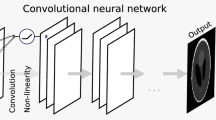Abstract
We propose a lightweight noise-canceling filtering neural network that implements the filtering stage in the algorithm for tomographic reconstruction of convolution and backprojection (Filtered BackProjection—FBP). We substantiate the neural network architecture, selected on the basis of the possibility of approximating the ramp filtering operation with sufficient accuracy. The network performance has been demonstrated using synthetic data that mimics low-exposure tomographic projections. The quantum nature of X-ray radiation, the exposure time of one frame, and the nonlinear response of the ionizing radiation detector are taken into account when generating the synthetic data. The reconstruction time using the proposed network is 11 times shorter than that of the heavy networks selected for comparison, with the reconstruction quality in the \(SSIM\) metric above 0.9.










Similar content being viewed by others
REFERENCES
Hu, Z. et al., An improved statistical iterative algorithm for sparse-view and limited-angle CT image reconstruction, Sci. Rep., 2017, vol. 7, no. 1, pp. 1–9.
Swensen, S.J. et al., Screening for lung cancer with low-dose spiral computed tomography, Am. J. Respir. Crit. Care Med., 2002, vol. 165, no. 4, pp. 508–513.
Thanh, D. et al., A review on CT and X-ray images denoising methods, Informatica, 2019, vol. 43, no. 2.
Johnson, C.A. and Sofer, A., A Data-parallel Algorithm for Iterative Tomographic Image Reconstruction, Proc. Frontiers’99. Seventh Symp. Frontiers of Massively Parallel Computation, IEEE, 1999, pp. 126–137.
Yang, H.K. et al., Slice-wise reconstruction for low–dose cone–beam CT using a deep residual convolutional neural network, Nuclear Science and Techniques, 2019, vol. 30, no. 4, pp. 1–9.
Adler, J. and Oktem, O., learned primal–dual reconstruction, IEEE Trans. Med. Imaging, 2018, vol. 37, no. 6, pp. 1322–1332.
Mizusawa, S. et al., Computed tomography image reconstruction using stacked U-Net, Comput. Med. Imaging Graphics, 2021, vol. 90, p. 101920.
Han, Y. and Ye, J.C., Framing U-Net via deep convolutional framelets: application to sparse–view CT, IEEE Trans. Med. Imaging, 2018, vol. 37, no. 6, pp. 1418–1429.
Nakai, H. et al., Quantitative and qualitative evaluation of convolutional neural networks with a deeper U-net for sparse-view computed tomography reconstruction, Acad. Radiol., 2020, vol. 27, no. 4, pp. 563–574.
Zhu, L. et al., Metal artifact reduction for X-ray computed tomography using U-net in image domain, IEEE Access, 2019, vol. 7, pp. 98743–98754.
Cierniak, R., A 2D Approach to Tomographic Image Reconstruction Using a Hopfield–type Neural Network, Artif. Intell. Med., 2008, vol. 43, no. 2, pp. 113–125.
Yang, Q. et al., Low-dose CT image denoising using a generative adversarial network with Wasserstein distance and perceptual loss, IEEE Trans. Med. Imaging, 2018, vol. 37, no. 6, pp. 1348–1357.
Bulatov, K. et al., Monitored reconstruction: computed tomography as an anytime algorithm, IEEE Access, 2020, vol. 8, pp. 110759–110774.
Hore, A. and Ziou, D., Image quality metrics: PSNR vs. SSIM, 2010 20th Int. Conf. Pattern Recognit., IEEE, 2010, pp. 2366–2369.
Kofler, A., et al., A U-nets cascade for sparse view computed tomography, in Int. Workshop on Machine Learning for Medical Image Reconstruction, Cham: Springer, 2018. P. 91–99.
Wei, Y., Wang, G., and Hsieh, J., An intuitive discussion on the ideal ramp filter in computed tomography (I), Comput. Math. Appl., 2005, vol. 49, no. 5–6, pp. 731–740.
Kak, A.C., Slaney, M., and Wang, G., Principles of Computerized Tomographic Imaging, 2002.
Adler, J., Kohr, H., and Öktem, O., ODL—a Python Framework for Rapid Prototyping in Inverse Problems, 2017. Code and documentation available online at https://github.com/odlgroup/odl .
Van Aarle, W. et al., The ASTRA toolbox: a platform for advanced algorithm development in electron tomography, Ultramicroscopy, 2015, vol. 157, pp. 35–47.
Funding
This work was partly financially supported by the Russian Foundation for Basic Research, projects nos. 19-01-00790 and 18-29-26017.
Author information
Authors and Affiliations
Corresponding authors
Additional information
Translated by V. Potapchouck
Rights and permissions
About this article
Cite this article
Yamaev, A.V., Chukalina, M.V., Nikolaev, D.P. et al. Neural Network for Data Preprocessing in Computed Tomography. Autom Remote Control 82, 1752–1762 (2021). https://doi.org/10.1134/S000511792110012X
Received:
Revised:
Accepted:
Published:
Issue Date:
DOI: https://doi.org/10.1134/S000511792110012X




